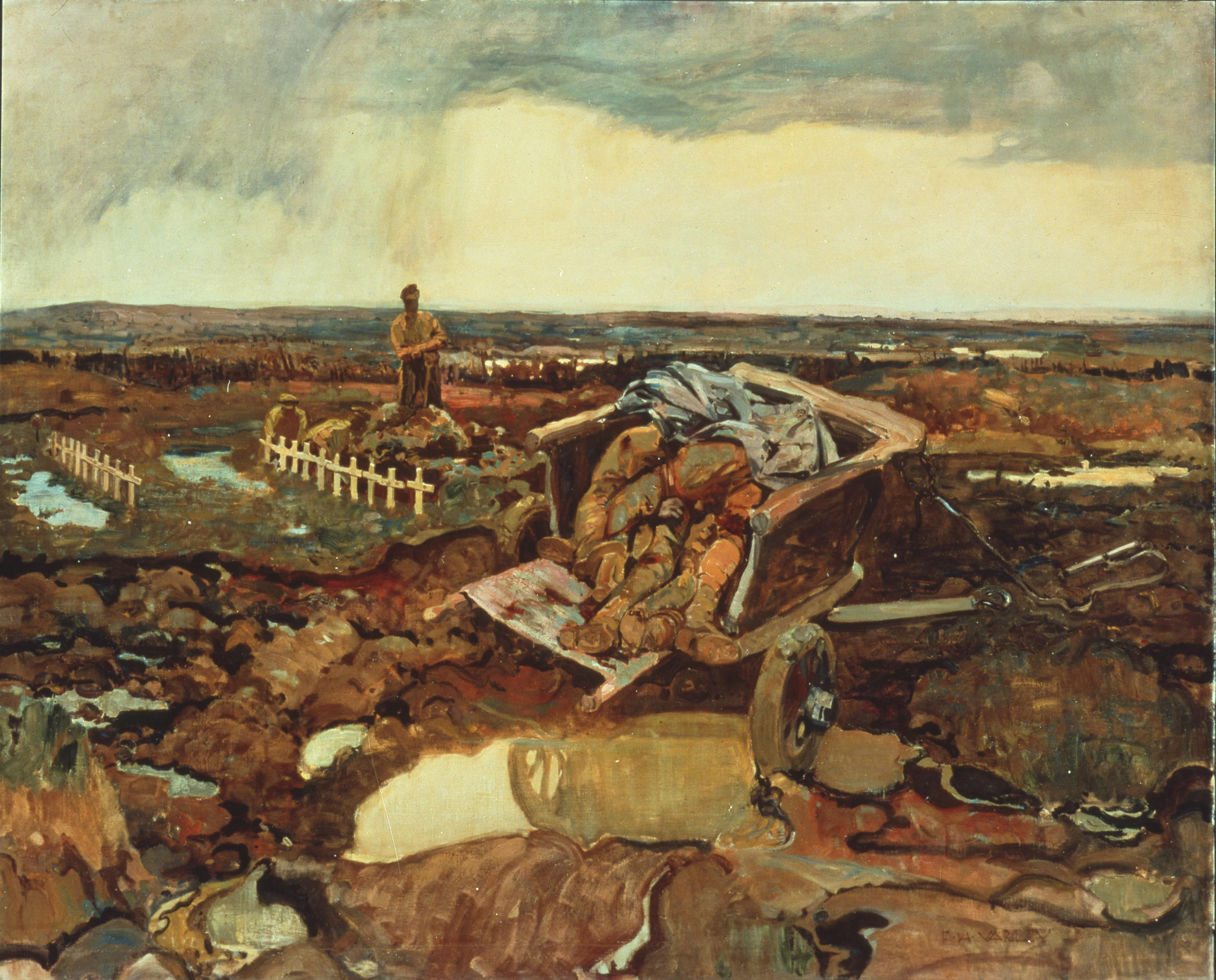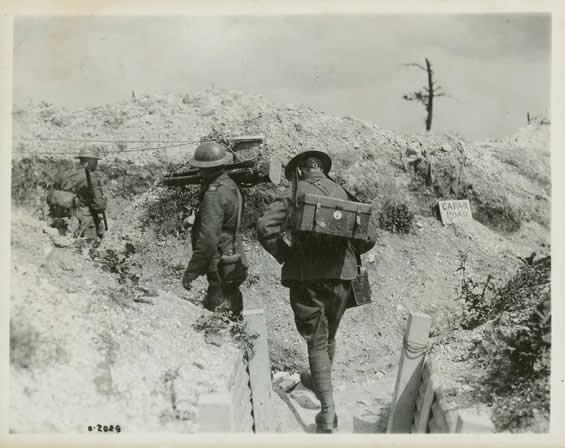Since the First World War, there have been four major initiatives to allow Canadian artists to document Canadian Armed Forces at war. Canada’s first official war art program, the Canadian War Memorials Fund (1916–19), was one of the first government-sponsored programs of its kind. It was followed by the Canadian War Art Program (1943–46) during the Second World War. The Canadian Armed Forces Civilian Artists Program (1968–95) and the Canadian Forces Artists Program (2001–present) were established to send civilian artists to combat and peacekeeping zones. Notable Canadian war artists have included A.Y. Jackson, F.H. Varley, Lawren Harris, Alex Colville, Molly Lamb Bobak and Mary Riter Hamilton.

First World War: Canadian War Memorials Fund
Canada’s first official war art program was the Canadian War Memorials Fund. It was established by Lord Beaverbrook and was run by the Canadian Army’s War Records Office (CWRO) during the First World War. From its inception in 1916 to its conclusion in 1919, the Fund hired more than 100 artists of British, Australian, Yugoslavian, Belgian and Canadian nationality. They produced canvases, works on paper and sculptures depicting Canada’s participation in the war. None of the roughly 1,000 works recording the farm and factory workers on the home front and the war-torn landscape of France and Flanders were exhibited during hostilities. At the war’s end, however, a large portion was shown in London, New York, Ottawa, Toronto and Montreal. (See also Documenting the First World War; Editorial: Canadian Art and the Great War; Representing the Home Front: The Women of the Canadian War Memorials Fund.)
DID YOU KNOW?
Only male artists received commissions for the battlefront during the First World War. However, a notable exception was Mary Riter Hamilton. She petitioned the Canadian War Memorials Fund to send her to the front lines as a war artist and was denied. But after the war ended in 1918, she was commissioned by the Amputation Club of British Columbia (now The War Amps) to paint battlefield landscapes for their veteran’s magazine, The Gold Stripe.Between 1919 and 1922, Hamilton created some 350 works from the warfront. It is the largest collection of Canadian First World War paintings by a single artist. The works displayed themes of destruction and renewal and were painted in an impressionist style, favouring colour and form over detail. Hamilton’s paintings were later exhibited in France, including at the Paris Opera House and at the Salon, and received high acclaim in Europe. In 1922, she was awarded the purple ribbon of the Order of the Academic Palms from France in recognition of her work.
Canada had been one of the first countries to establish a war art program. As a result, it had produced a visual record of the war that was second to none. F.H. Varley’s For What? was visual proof that the war artists had seen the dark underside of war. And A.Y. Jackson’s Screened Road "A" showed that the war-torn, pock-marked landscape had become a valid subject for the war artist.
But the value of the Canadian War Memorials Fund lay not only in the collection of works assembled. Participation in the Fund’s exhibitions immediately following the war gave artists an opportunity to have their work evaluated by leading critics and gallery officials. The whole experience of painting the landscape in France and Flanders; of viewing the war scenes produced by British modernists; and of having some involvement with major art critics, patrons and gallery officials, was a crucial factor in elevating the art of the Group of Seven and its followers to national status. The Fund not only gave Canadians a memorial of their participation in the war; it also gave Canadian art and artists an important place within the cultural framework of inter-war Canada.

Second World War: Canadian War Art Program
The Second World War broke out in the autumn of 1939. Yet Canada did not have an official war art program in effect until 1943. The Canadian War Art Program was created largely through the efforts of Vincent Massey and the director of the National Gallery of Canada, H.O. McCurry. The program came under the jurisdiction of the Department of National Defence. This time, only Canadian artists serving in the armed forces were employed. (See also Documenting the Second World War.)
The Canadian War Art Program was smaller in scale than the Canadian War Memorials Fund. Only 32 artists were given war artist commissions. However, the record included Canadian activities in North Africa, off the Alaskan coast at Kiska, in the North Atlantic and the Pacific, as well as in Canada, Britain and Europe. Paintings were exhibited during the war — sometimes directly behind fighting operations.
The collection of the Canadian War Art Program totals approximately 5,000 works. Taken as a whole, it was less concerned with depicting the land than the men and machines. Lawren Harris’s Tank Advance (1944) is a wonderful evocation of the mood, the tone and the domination of the landscape by machines. Charles Comfort’s Dead German on the Hitler Line depicts the horrific results of war. Alex Colville’s Tragic Landscape juxtaposes the terror of war with the peacefulness and tranquility of nature. The contrast of these opposing realities gives the work a feeling of angst and a sense of uncertainty, qualities that would be the hallmark of Colville’s later work.
Later Conflicts and War Art Programs
Canada did not commission war artists to record military activities in the Korean War. This did not, however, prevent individual soldiers, such as Ted Zuber, from making a record of their front-line experience when they returned to Canada.
In 1968, however, the Canadian Armed Forces Civilian Artists Program was established by the Department of National Defence. This organization sent civilian artists to Vietnam, Europe, the Middle East and other locales to ensure that the representation of Canada’s armed forces continued. The program was discontinued in 1995 due to funding cuts. It was brought back in 2001 as the Canadian Forces Artists Program. This initiative was expanded to include musicians, actors and writers and well as painters, filmmakers and sculptors. As of April 2020, more than 60 artists have contributed to the program, including Mini Onodera (who was in Afghanistan in 2006) and Louie Palu (who has covered conflicts in Afghanistan, Pakistan, Mexico and Ukraine).
See also: Monuments of the First and Second World Wars; Memorials and Honours; Canadian War Museum.

 Share on Facebook
Share on Facebook Share on X
Share on X Share by Email
Share by Email Share on Google Classroom
Share on Google Classroom



